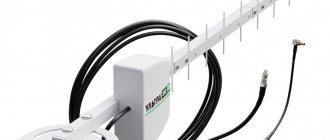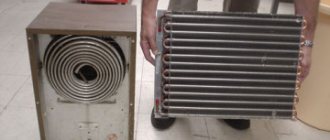Remote control device
A household remote control is a box with buttons on the front.
The remote control operates on batteries and sends signals in the form of infrared rays (0.75 - 1.4 microns). The wave is not recognized by a person, but is perceived by the receiving mechanism. The design contains a packaged or packaged microcircuit, which is located on a dielectric plate and filled with a polymer thermoplastic resin. The universal remote control panel has the following basic parts:
- power key, device selection;
- volume control and channel switching, date and time settings;
- numeric keys for entering numbers;
- programming buttons;
- joysticks for menu navigation;
- keys, the purpose of which is chosen by the user independently;
- LCD or touch screen showing current information.
Devices with many functions require a complex system with wave frequency regulation, which also protects the channel from interference and encodes the commands being sent. Digital conversion is used by the remote control chip and decoding by the receiver.
Operating principle of the remote control
More often, devices use one frequency modulation (radiation from an LED element), to which the receiver and remote control are tuned. Frequency values with constant amplitude are usually unchanged - these are 36, 38 or 40 kHz (Button, Canon, Pro Black). 56 kHz indicators are rarely used (Sharp, Runva, Doorhan). Bang & Olufsen products operate at 455 kHz, which is a rare characteristic.
If the frequency of the receiver and transmitter do not match, the remote control will work, but its sensitivity will decrease. Several modulated bursts of pulses create a coded message, and the receiver contains a demodulator, a filter circuit, and a frequency detector.
Previously, only the basic commands of the controlled device were placed on the remote control; most of the controls were located on the body of the household appliance. The situation has changed: ventilation, gates, lighting, and traffic light equipment can only be controlled using a remote device.
Remote switch design
The switch is very easy to disassemble. It is enough to use a screwdriver to pry out the slots at the junction of the cover and the body. There is no need to unscrew any screws.
Inside it is:
- electronic board
- central on/off button
- LED for visualizing the connection between the switch and the radio module
- battery type 27A 12 volt
This battery, even with intensive use, can last 2 years or more. In addition, there is no particular shortage of them at the moment. It may not be included in the package, please keep in mind.
By the way, the switch is initially universal. On the sides of the central button, there are places where you can solder two additional buttons.
And by changing the key itself, you can easily change from a single-key to a two- or even three-key one.
True, in this case you will have to add more modules, according to the number of buttons.
There is a hole on the radio module box. It is intended for a button, when clicked, you can “bind” or “erase the binding” of a particular device.
In terms of radio signal range, the manufacturer claims a distance from 20 to 100 meters. But this applies more to open spaces. From practice, we can say that in a panel house the signal easily penetrates four concrete walls at a distance of 15-20 meters.
There is a 5A fuse installed inside the box. Although the manufacturer indicates that through a remote switch you can connect a load of 10A, which is as much as 2kW!
The diagram for connecting wires to the contacts of the radio module of the wireless switch is as follows:
When connecting, you can also navigate by the labels. Where there are three terminals there is an output, where there are two terminals there is an input.
- L out – phase output
- N out – zero output
Connect the wiring to the light bulb to these contacts. Supply voltage 220V to the two contacts on the other side.
On the side of the output contacts there are three more points for soldering jumpers. By re-soldering them accordingly (as in the figure), you can change the logic of the product:
When the key is pressed, the relay contacts close. When released it will turn off.
This can be used to make a call or to give a short-term signal of some kind. There is also a middle contact “B”. When using it, the switch will operate in inverse mode.
Types of wireless remote controls
Built-in remote control
The devices are powered by 2 - 4 removable batteries of type AA, AAA, less commonly used 9 V Krona batteries. The IR LED requires 2.5 volts to operate, so several elements are required to ensure the remote control level. Experts recommend alkaline or salt batteries.
Depending on the type of power supply, there are remote controls:
- autonomous;
- devices powered from a 220 V electrical network or with a 360 V converter.
They produce portable devices that are often used in everyday life for wireless control of lamps, chandeliers, gate opening, tail lift operation, and other switches. The built-in IR remote control is installed to control complex smart home systems or installed in industrial complexes to control, for example, a crane.
Control devices are classified according to functionality:
- with a limited number of teams;
- with a choice of the number of orders (universal option, for example brand ABCD);
- with the ability to train a set of signals (trainable models, for example, DC V).
ABCD remote control
DC V remote control
Communication with the controlled equipment is established mechanically or wired, using a radio channel, WI-FI, ultrasonic and infrared methods. The Trodfrey driver controls the light in a home remote control, and Wireless USB replaces standard wired transmissions.
One-button remote control for ten positions
The circuit is designed to sequentially switch ten loads or states of a device. Control is carried out using a simple and compact remote control with one button. To control, you need to press this button and hold it pressed. In this case, ten outputs are switched sequentially in a ring, with the enabled output indicated by an LED. As soon as the desired output is turned on, the remote control button must be released.
The schematic diagram of the remote control is shown on the website. Infrared radiation modulated at a frequency of 38 kHz is used here as a control signal transmission channel. Command one is a sending of such radiation, lasting as long as the output switch is held, which opens when a signal modulated with a frequency of 38 kHz is received. Thus, when a signal is received, the F1 output is zero. The level from output F1 goes to two parallel-connected elements D1.3 and D1.4. When their inputs are zero, their output is one.
And the capacitor SZ is charged slowly through resistor R4. When output F1 is one, outputs D1.3 and D1.4 are zero, and capacitor SZ discharges quickly through diode VD1 and resistor R3. Thus, if the photoreceiver accidentally receives a signal from a standard household appliance remote control, the F1 output will not have a constant logic level, but pulses. And the capacitor SZ will not have time to charge to the voltage of the logical unit. If the signal comes from your own remote control (in Fig. 1), then the outputs D1.3 and D1.4 will not have pulses, but a logical one for a long time, and the SZ will be able to charge to a logical one.
The voltage from the SZ will go to pin 6 of D1.2 and will trigger the multivibrator on elements D1.1 and D1.2, pulses from the output of which will go to pin 14 of counter D2. The counter counts these pulses and its outputs switch sequentially. Switching can be monitored by the HL1HL10 LEDs, which are connected to its outputs. The switching speed of the outputs of the counter D2 depends on the pulse frequency at the output of the multivibrator D1.1D1.2. During setup, you can set the desired switching speed by selecting resistance R6.
As soon as the desired LED lights up, the remote control button must be released, the capacitor SZ will quickly discharge through R3 and VD1, and there will be a logical zero at pin 6 of D1.2, the multivibrator will turn off and the counter D2 will stop in the state in which it will be at that moment. Button S1 (Fig. 2) is needed for direct control (without a remote control). All microcircuits can be replaced with foreign analogues, for example, K561LA7 can be replaced with CD4011, and K561IE8 with CD4017.
The FH415U IR LED can be replaced with any IR LED designed for remote controls. The SFH50638 photodetector can be replaced with any similar photodetector. In this case, you will need to find out what modulation frequency it is designed for (usually the last two digits are indicated in the marking). And set the multivibrator of the remote control to the same frequency. LEDs HL1HL10 of any high brightness, indicator. The main point of adjustment is pairing the frequency of the remote control multivibrator with the frequency of the photodetector. You need to replace R2 of the remote control with a variable resistor, close the S1 button of the remote control with a jumper. Using a multimeter, monitor the voltage at pin 1 of F1.
And by adjusting R2 (Fig. 1) ensure that output F1 (Fig. 2) is logical zero at the greatest distance from F1 of the remote control. Then, remove the jumper from S1 (Fig. 1) and unsolder the variable resistor connected instead of R2 (Fig. 1), measure its resistance and solder in place of R2 a resistor of the closest value to the measured one. If you use any binary counter instead of a binary decimal counter of the K561IE8 type, it will be possible to switch combinations of outputs according to the binary code, that is, if the counter is four-bit, the circuit will have four outputs and 16 combinations of their states.
To these outputs, using intermediate keys, you can connect lamps from a chandelier or suspended ceiling through optorelays (optotriacs), and switch them with a remote control, choosing the desired combination of them on and off. You can feed the output of a binary counter to a resistive matrix, and thus regulate the constant voltage at its output in 16 steps from logical zero to logical one. Of course, there may be other options for using this scheme.
Remote control diagram
An encoding method is used to distinguish the commands of the transmitting block. Before broadcasting the signal, the remote control issues one or more synchronous packets so that the touch receiver sets up the receiving circuit and synchronizes with the transmitter in phase and degree of sensitivity.
Two schemes have been developed for this purpose:
- The first system is used in the Philips remote control (in accordance with the RC5 and RC4 protocols). The sending of signal 0 is supplemented by the number 1, and sending 1 requires the addition of 0. Signal 001 arrives in the form of 010110 and is read sequentially, and a simulated packet is sent into space.
- The authors of the second encoding scheme are representatives of Sony. One is transmitted in a modulated burst, and zero means a pause. Zero transmits encoded information at the same time indicator of one.
Studies have shown that the duration of signals varies by time deviations at the level of +-10%. Transmitted packets are modulated by changing the frequency, which affects the operating range of the device.
How to make a remote control with your own hands
4-channel remote control circuit
The remote control is a device that can be assembled by converting a smartphone. You need to purchase infrared diodes or remove them from unnecessary remote controls (2 pieces) and a plug from old headphones. For assembly you will need sandpaper, electrical tape and superglue; the work is carried out with wire cutters and a soldering iron.
The following steps are performed for manufacturing:
- On one side, the elements of the IR diodes protruding from the sides are cleaned using sandpaper.
- The diodes are connected using superglue so that the ground side is inside.
- The legs of the diodes need to be bent and the excess protrusions removed with pliers.
- The anodes are soldered to each other using a soldering iron.
- Similar processing of the second diode is carried out;
- Both LEDs must be connected to the plug lugs without observing polarity.
- The soldering area is coated with glue and protected with insulating tape.
The connection mode is done via IR Port or WI-FI, IR Blaster. The TV modification is selected and the action is confirmed. The converted smartphone is sent to the IR receiver of the home screen, and the functions are controlled.
Connecting your smartphone as a TV remote via Wi-Fi
Smartphones have replaced many electronic and mechanical devices for people. Nowadays you almost never see alarm clocks, calculators, voice recorders and other previously necessary devices. In addition to all the devices listed, a modern mobile device can even replace a TV remote control.
This process is accomplished in two main ways:
- via wi-fi connection;
- via infrared port;
- TV regulation through specialized smartphone applications.
First, let's look at the Wi-Fi Direct function. This is a way to control a TV through a phone, which requires connecting two devices of interest to the user to the same wireless network.
Before we consider the method of connecting a smartphone to a TV via the Wi-Fi Direct function.
| Advantages | Flaws |
| Allows you to watch programs of interest from applications on your smartphone | The function allows you to watch only files from your smartphone |
| Replaces the function of the remote control and TV tuner | Wi-Fi Direct is not available on all TV models |
To connect Wi-Fi Direct, you must follow these instructions:
- Go to your mobile device settings.
- Find the tab responsible for the wireless connection (Wi-Fi).
- Activate Wi-Fi Direct.
- Enable the same option on the TV of interest. The TV will show a list of devices that can be connected.
- Next, we should select the smartphone we are interested in and confirm the connection in the window that will appear on the display of the mobile device.
If all of the above steps in the instructions were completed correctly, then the phone will be connected to the TV using the Wi-Fi Direct function. However, this type of device connection cannot be considered a full replacement for the remote control, so we will consider other ways to replace this device using a smartphone.
Scope of use of remote control
A universal remote control controls several types of consumer electronics. Such a device differs from a local device, which is sold together with a washing machine, X-box or camera. UP is sold as a separate product and purchased separately.
Different manufacturing technologies affect the final actions of the device and its cost. Remote controls control one or more units, the range of application is determined by the manufacturer. Trainable models make it possible to specify a list of coordinated equipment through programming.
In everyday life, the IR remote control works with all modern models of household appliances, is used in a complex home automation system for climate control, organizing burglary protection, opens and closes entrance openings, and adjusts the operating mode of cooking and heating units.
Advantages of remote controls
The transition to remote control provides convenience for the user, since there is no need to move around the home to turn on the lights and set the microclimate parameters in the room. In an automated system, a person can use a remote control to ensure high-quality work at home without leaving his seat.
Remote response works successfully when objects are remote from the operator, for example, when coordinating aircraft, airplanes, and cars. Beacons, repeaters, and radio communication stations are controlled at a distance and do not require the direct presence of a person.
Games like Xbox previously used a wired communication system, but the change to wireless remotes gives players more options.
Advantages and disadvantages
The ability to control the light from a remote control or other control device has the following advantages:
- Availability of installation and connection.
- Smooth adjustment of lighting characteristics of lamps.
- Programming a schedule for turning the lights on and off, creating a “presence effect”.
- Optimization of energy consumption.
- Saving the working life of lamps.
Saving energy and extending the service life of lamps are the main advantages of a light control system Source avtcom.ru
- Turning on and off several lighting devices at the same time.
- Monitoring the safety of electrical appliances at home.
The disadvantages of systems for controlling lighting devices at a distance are manifested in the high cost of equipment and the influence of extraneous factors on the nature of their operation, for example, such as precipitation for outdoor devices, as well as the movement of warm air indoors.











